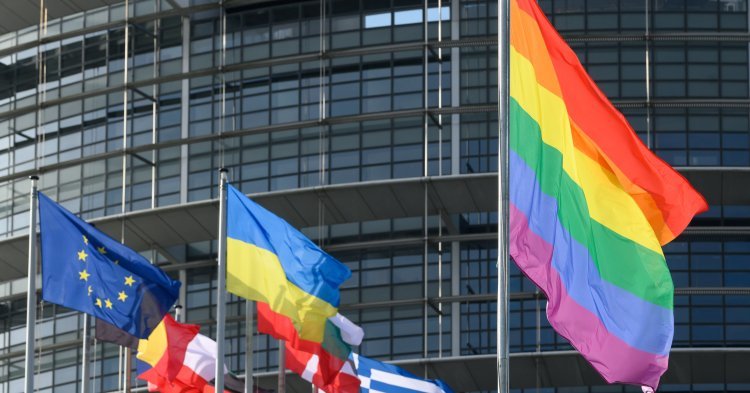In a somewhat mixed assessment of the LGBTQ+ rights situation, the European Commission is proposing a strategy for equality. Between pretty words and concrete actions, what should we take away from this valuable initiative? Let’s revisit some aspects of the strategy that deserve to be highlighted.
Although the EU is one of the most protective spaces for minorities, including LGBTQ+ people, the reality of their lives is far from perfect. As is often the case at EU level, there are huge disparities [1]. In its annual review, ILGA-Europe provides a ranking of 49 European countries according to their legal framework for LGTBQ+ people. Malta achieved the highest score with almost 90% whilst Poland is the last EU member state — ranked 42nd with a score of 15.84% (on a scale ranging from 0% —flagrant violation of human rights, discrimination— to 100%). In a nutshell, the EU stands out as a union with many regional disparities that stir it up. As Ursula von der Leyen promised in her state of the Union speech last September, here it is, only two months later: a strategy for equal treatment of LGTBQ+ people.
This strategy consists of an action plan based on four pillars which concern tackling discrimination, ensuring safety, building inclusive societies and leading the fight for LGBTQ+ equality around the world. With this, the Commission sets a clear and bold objective for the EU “to be at the forefront of efforts to better protect the rights of LGBTIQ people”.
The European Union’s difficulty in making equality laws
As part of the LGBTQ+ anti-discrimination pillar, the Commission proposes in particular to improve legal protection against discrimination on the basis of sexual orientation. In an area like employment, the EU has always been a leader, and very active. The Commission reiterates its 2008 proposal for a directive on equal treatment, which would extend the legal protection offered by EU law against discrimination in employment, especially on grounds of sexual orientation. However, the conclusion is indisputable: after having been discussed 12 times between 2016 and 2019, the draft directive remains at a stalemate. Some delegations questioned the very necessity of the proposal, arguing that it infringed on the authority of member states and was contrary to the principle of subsidiarity and proportionality. As discussions stood on 27 May 2019, two member states maintained general reluctance about the proposal. As this directive must be approved by the Council unanimously, this obstacle may not be overcome in the near future.
In addition, the Commission pledges to propose an initiative by 2021 to extend the scope of the 2008 Council framework, to combat certain forms and expressions of racism and xenophobia by means of criminal law. In this way, the Commission hopes to add gender identity and sexual orientation to the list, criminally punishable by Member States if race, colour, religion, nationality or ethnicity incites public violence or hatred. Even if this were to succeed, it is likely to be mainly symbolic: many member states already have these laws in place, without actually having an effective or systematic criminal justice response.
This last example of the Union’s inability to propose a binding standard framework is the strategy’s pillar of fighting for the equality of LGBTQ+ people around the world. This is not new, but the EU’s Common Foreign and Security Policy is still at an embryonic stage. Indeed, member states are fervently clinging on to their sovereignty as treaties are revised. This last pillar, which the strategy put forward by Mrs von der Leyen is structured around, can be seen rather as an abstract declaration of intent that lacks concrete action. The Commission’s encouragement and incentives for member states to uphold “good practice” on a voluntary basis is a testament to the EU’s inability to enforce this. Brussels’ strategy does not make use of an updated legal framework, but rather assured financial support.
The Commission dips into its wallet
The lack of legally binding EU initiatives is dubious, but it should be recognised that the Commission commits financially to this strategy of equal treatment for LGBTQ+ people. Indeed, the term ‘funding’ comes up fifteen times in the strategy’s text. Thus, as the press release accompanying the strategy’s publication reiterates, the Commission will offer funding opportunities for initiatives that aim to fight hate crime, hate speech and violence against LGBTQ+ people. Taking a closer look at the strategy, it doesn’t offer many new funding opportunities but allows programs that already exist to be oriented or reoriented. For example, the Commission, in order to fight against inequality in education, health, culture, and sport proposes reinforcing consideration of LGBTQ+ peoples’ equality in the EU’s funding programs like EU4Health or the famous Erasmus+ programme.
This committed position is perhaps a missed opportunity to send out a strong message. The statement should be nuanced, and eventually, positively welcomed. Indeed, it would be pointless to create a single fund when LGBTQ+ equality must be sought in all areas. Therefore a single fund would not be appropriate from this perspective.
A strategy affected by current affairs
This strategy is part of the context of the COVID-19 pandemic, which is currently rocking the continent, but is also part of the broader European context, and in particular the Commission’s political agenda. With regard to the context of public health, it is through the real circumstances of the separation of couples and families during the closure of some intra-European borders that the Commission intends to improve legal protection of LGBTQ+ families in cross-border situations by revising its guidelines on the topic.
As far as the European political agenda is concerned, the Commission hasn’t forgotten to include equality for LGBTQ+ in the coming reform for the European asylum system (Dublin Regulation III). It seeks to ensure appropriate protection for vulnerable asylum seekers, especially LGBTQ+ people, with a stated goal to defend the rights of those who seek international protection. Finally, how should we describe the Commission’s strategy: daring but not ambitious enough? The EU doesn’t seem to be ready to overcome the obstacle of certain member states’ reluctance. However, it’s probably a good thing that such a strategy has been adopted in order to start the debate in European civil society, and perhaps in the end lead to tangible change for the rainbow community. As the aptly-titled 2020 report by the EU Agency for Human Rights summarises: there’s still “A long way to go for LGBTI+ equality”.


Follow the comments: |
|
